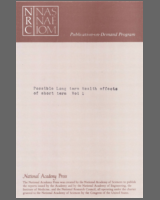NCBI Bookshelf. A service of the National Library of Medicine, National Institutes of Health.
National Research Council (US) Panel on Anticholinesterase Chemicals; National Research Council (US) Panel on Anticholinergic Chemicals. Possible Long-Term Health Effects of Short-Term Exposure to Chemical Agents: Volume 1 Anticholinesterases and Anticholinergics. Washington (DC): National Academies Press (US); 1982.

Possible Long-Term Health Effects of Short-Term Exposure to Chemical Agents: Volume 1 Anticholinesterases and Anticholinergics.
Show detailsThe Department of the Army asked the Committee on Toxicology (COT) of the National Research Council (NRC) Assembly of Life Sciences to conduct a study of the possible chronic adverse health effects on servicemen of experimental exposure to various chemicals at U.S. Army Laboratories at Edgewood, Maryland, in about 1958–1975. The Edgewood tests were conducted to learn how specific chemicals may affect humans. Some 6,720 soldiers took part in the program; 254 chemicals were administered by various routes. Chemicals were tested for various military applications. Among them were acutely toxic anticholinesterase chemicals; incapacitating agents, which included the glycolates, atropine-like anticholinergic compounds of which BZ (3-quinuclidinyl benzilate) is a prototype; the indoles, represented by EA 1729 (LSD-25); the cannabinols, or marijuana-like compounds; and the sedative, or “tranquilizer,” group.
Review of the Edgewood tests included interviews with key administrators, investigators, nurses, and technicians. The account of practices and procedures undertaken at Edgewood comes from a wide spectrum of sources, both documents and interviews. They represent a wide spectrum of attitudes, but are essentially in agreement. Committees were formed at Edgewood to review classified chemicals and reports for declassification and use by NRC panels. Extensive extracts were prepared of preclinical animal and human protocols and technical reports at Edgewood Libraries and other Edgewood facilities where records of subjects and details of exposure conditions and clinical findings are maintained. A repository was established at Edgewood Arsenal (August 1980) for storing the reports and information obtained from other sources.
The NRC staff organized the test chemicals into several pharmacologic classes; the first two classes consisted of 15 anticholinesterase (Appendix A) and 24 anticholinergic (Appendix B) chemicals. Two expert panels were established (on anticholinesterases and on anticholinergics) with chairmen selected from the COT and members drawn from the scientific community on the basis of familiarity with some aspect of the pharmacologic class involved or expertise in a discipline needed for proper evaluation of potential adverse health effects.
Research and experimental case files on volunteers were extracted and summarized. Digests of the literature were prepared.
The charge of the two panels was to determine whether, on the basis of the data available, it is possible to demonstrate the likelihood of long-term health effects or delayed sequelae and, if so, whether the involved chemicals, as tested, are likely to produce long-term health effects or delayed sequelae. The charge did not include policy recommendations regarding human testing. This report is the first of two on the Edgewood tests. It presents the two panels' tentative conclusions which are based on a review of data obtained from Edgewood in nine documents provided by NRC staff (listed in Appendixes C and D), on mortality data organized by the NRC Medical Follow-Up Agency, and on separate discussions and papers generated by the panel members. Specific issues addressed were based on this information and relevant items from the published literature.
A second report will contain an evaluation of most of the remaining chemicals tested at Edgewood and an evaluation of the effects on morbidity state of the test subjects. The information on morbidity may permit firmer conclusions than are presented here.
- PREFACE - Possible Long-Term Health Effects of Short-Term Exposure to Chemical A...PREFACE - Possible Long-Term Health Effects of Short-Term Exposure to Chemical Agents
Your browsing activity is empty.
Activity recording is turned off.
See more...